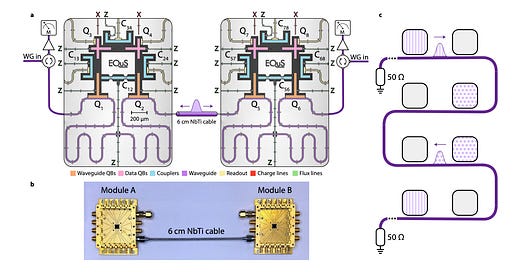MIT researchers have developed a novel interconnect device enabling direct communication among multiple quantum processors, addressing current limitations in connectivity and error rates. This device
MIT researchers have developed a novel interconnect device enabling direct communication among multiple quantum processors, addressing current limitations in connectivity and error rates. This device facilitates all-to-all communication by using microwave photons transmitted through superconducting waveguides, allowing any number of modules to be connected efficiently.
The researchers demonstrated remote entanglement between two quantum processors, a critical step toward building scalable quantum networks. Their work highlights the potential for creating highly flexible and efficient quantum computing architectures, paving the way for future advancements in distributed quantum processing.
Introduction to Quantum Communication Needs
Quantum communication requires efficient and reliable methods for transferring information between quantum processors. In classical computing, data transfer between components is straightforward, but maintaining coherence and minimizing communication errors presents unique challenges in quantum systems. Current quantum interconnects often rely on point-to-point connections, which can become inefficient as the number of processors increases, leading to higher error rates due to multiple transfers.
To address these limitations, researchers at MIT have developed a novel quantum interconnect that enables all-to-all communication among quantum processors. This device uses microwave photons transmitted through superconducting waveguides, allowing direct communication between any pair of processors in a network. The system employs modules equipped with qubits that emit and absorb photons, facilitating quantum information transfer.
A key innovation is using reinforcement learning to optimize photon propagation, ensuring high absorption efficiency despite distortions in the waveguide. This optimization enables remote entanglement generation, a critical capability for scaling quantum systems. The research was supported by notable funding sources, indicating significant interest from academic and military perspectives.
MIT's New Interconnect Device
The MIT-developed quantum interconnect device enhances communication among quantum processors by enabling all-to-all connections via superconducting waveguides. This approach addresses the inefficiencies of traditional point-to-point systems by allowing direct communication between any pair of processors in a network. Each module uses qubits to emit and absorb microwave photons, facilitating efficient data transfer while preserving quantum coherence.
Reinforcement learning plays a crucial role in optimizing photon propagation within the device. This method achieves over 60% absorption efficiency by mitigating distortions in the waveguides, which is essential for remote entanglement generation—a critical capability for scaling quantum networks. The research was supported by notable funding sources, highlighting its importance to both academic and military communities.
Photon Emission and Absorption Mechanism
The device's functionality relies on a sophisticated photon emission and absorption mechanism. Each module is equipped with qubits that emit microwave photons, which are then transmitted through superconducting waveguides. These photons are absorbed by other modules in the network, enabling direct communication between processors.
This mechanism ensures efficient data transfer while preserving quantum coherence, addressing inefficiencies inherent in traditional point-to-point interconnects. The system's design supports scalability, offering potential improvements such as integrating modules in 3D configurations or enhancing protocol speeds to optimize performance further and expand capabilities.
Optimization with Reinforcement Learning
Reinforcement learning is a cornerstone of the device's optimization strategy. By fine-tuning photon propagation within the waveguides, this approach mitigates distortions and achieves over 60% absorption efficiency—a critical factor for enabling remote entanglement generation. This capability is essential for scaling quantum networks and building larger, more complex systems.
Integrating modules in 3D configurations could optimize performance by reducing physical space and improving photon travel paths. Enhancing protocol speeds would further reduce error accumulation, supporting scalable quantum computing architectures. These developments underscore the device's potential to address key bottlenecks in the field of quantum communication.
Future Directions and Scalability
The MIT-developed quantum interconnect device offers promising directions for future advancements in quantum communication. Its architecture supports scalability, with potential improvements such as integrating modules in 3D configurations or enhancing protocol speeds to optimize performance further and expand capabilities.
The device addresses the inefficiencies of traditional point-to-point systems, paving the way for more efficient and reliable quantum networks. Notable funding sources supported the research, reflecting significant interest from academic and military perspectives. These developments are crucial for building larger and more complex quantum systems and addressing key challenges in the field.
More information
External Link: Click Here For More





Fascinating this is so much more important than this current obsession with AI and LLM.